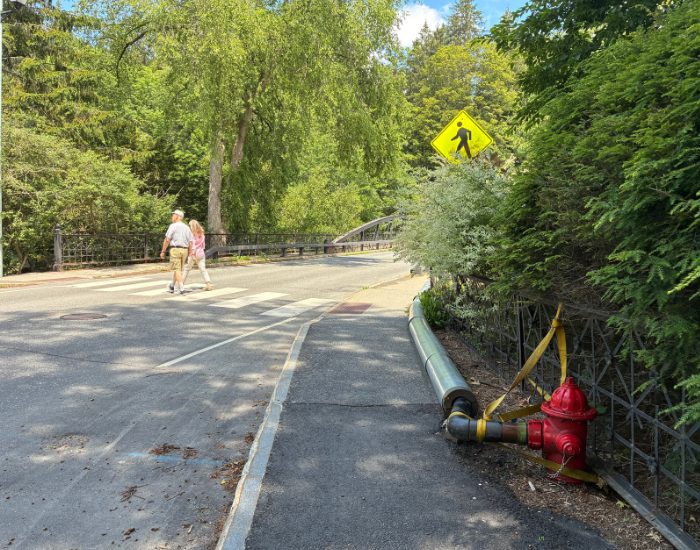
This temporary water main has run across the Elm Street Bridge since the 2023 floods, and will be replaced with funding from the NBRC grant.
We are thrilled to announce that the Town of Woodstock has been awarded a Northern Border Regional Commission (NBRC) grant of $868,858.52. This grant will fund up to 50% of the cost of two key projects to upgrade Woodstock’s drinking water system: the design, permitting, and construction of a new well to replace of one of Woodstock’s municipal water supply wells, and the installation of a new water main suspended under the Elm Street bridge that will increase resilience to future flood events. The increased flow and pressure from this work will enable the water system to support hundreds of new units of housing and the creation of new local businesses.
In October 2024, the Town of Woodstock acquired the Woodstock Aqueduct Company. Voters approved the purchase of the private utility and passed a bond measure to fund urgent repairs aimed at resolving system deficiencies—especially low fire hydrant pressure that has prevented new connections to the system. In addition to that critical work, the water system still faces several million dollars in other identified needs. This grant will help defray the cost of the bond-funded work, potentially allowing the Town to reallocate the money that has been freed up to other water projects.
In July 2023, the underground water main that crossed the Ottauquechee River at Elm Street was destroyed by flooding. As a result, Woodstock Village was under a boil water order for two weeks. The evidence of this event is still in plain view–a temporary pipe still runs on the sidewalk over the bridge. This newly awarded grant will fund a pipe suspended from the Elm Street Bridge that will make the main accessible during flooding and eliminate the possibility of floodwaters contaminating the Village’s drinking water supply. The grant will also fund a new supply well to increase water production. The new 24” x 18” x 65’ deep well will provide approximately 450 gallons per minute.
According to the 2025-2029 Vermont Housing Needs Assessment, Windsor County needs between 2,051 and 3,120 new homes by the end of the decade. Our existing housing stock is unaffordable for the hundreds of current and prospective workers who serve Woodstock’s sizeable tourism industry, and the need for new workforce and affordable units is particularly acute. Affordable housing will not be possible without upgrades to the water system. Woodstock is also an aging town with a median age of 55–11 years higher than the state average–and there is a growing need for new affordable housing for seniors. The water system’s service area currently provides domestic water supply to several senior housing complexes, including The Homestead, Woodstock Terrace, and the Mellishwood Apartments. Upgrades to the water system will be of particular benefit to Mellishwood, which is currently planning for a 28-unit expansion.
The NBRC grant application was written by Harry Falconer, Woodstock’s Shared Energy Coordinator (SEC). The Energy Coordinator position was created by a vote at Town Meeting Day in 2020 after advocacy by Sustainable Woodstock. Woodstock funds the role in partnership with six other towns, receiving a proportional number of the SEC’s hours in return. The SEC is administered through the Two Rivers-Ottauquechee Regional Commission and guided by a steering committee that includes Sustainable Woodstock’s Executive Director. This grant award shows the importance of investing in staff like our Energy Coordinator to work on long-term planning and sustainability.
The Town may put a bid out for the projects as early as this summer. Once contractors have been secured, the final design and permitting process is expected to take approximately six months. Construction of the new well is estimated to take place between winter 2025-2026 and summer of 2026. The water main under the Elm Street bridge will likely be completed between fall of 2026 and summer of 2027, depending on contractor availability and the length of the permitting process.